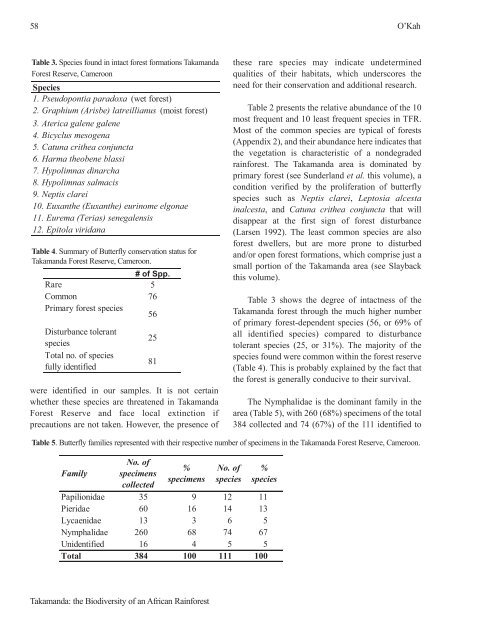Fisheries in the Southern Border Zone of Takamanda - Impact ...
Fisheries in the Southern Border Zone of Takamanda - Impact ...
Fisheries in the Southern Border Zone of Takamanda - Impact ...
You also want an ePaper? Increase the reach of your titles
YUMPU automatically turns print PDFs into web optimized ePapers that Google loves.
58 O’Kah<br />
Table 3. Species found <strong>in</strong> <strong>in</strong>tact forest formations <strong>Takamanda</strong><br />
Forest Reserve, Cameroon<br />
Species<br />
1. Pseudopontia paradoxa (wet forest)<br />
2. Graphium (Arisbe) latreillianus (moist forest)<br />
3. Aterica galene galene<br />
4. Bicyclus mesogena<br />
5. Catuna cri<strong>the</strong>a conjuncta<br />
6. Harma <strong>the</strong>obene blassi<br />
7. Hypolimnas d<strong>in</strong>archa<br />
8. Hypolimnas salmacis<br />
9. Neptis clarei<br />
10. Euxan<strong>the</strong> (Euxan<strong>the</strong>) eur<strong>in</strong>ome elgonae<br />
11. Eurema (Terias) senegalensis<br />
12. Epitola viridana<br />
Table 4. Summary <strong>of</strong> Butterfly conservation status for<br />
<strong>Takamanda</strong> Forest Reserve, Cameroon.<br />
# <strong>of</strong> Spp.<br />
Rare 5<br />
Common 76<br />
Primary forest species<br />
56<br />
Disturbance tolerant<br />
species<br />
Total no. <strong>of</strong> species<br />
fully identified<br />
were identified <strong>in</strong> our samples. It is not certa<strong>in</strong><br />
whe<strong>the</strong>r <strong>the</strong>se species are threatened <strong>in</strong> <strong>Takamanda</strong><br />
Forest Reserve and face local ext<strong>in</strong>ction if<br />
precautions are not taken. However, <strong>the</strong> presence <strong>of</strong><br />
Family<br />
<strong>Takamanda</strong>: <strong>the</strong> Biodiversity <strong>of</strong> an African Ra<strong>in</strong>forest<br />
25<br />
81<br />
No. <strong>of</strong><br />
specimens<br />
collected<br />
%<br />
specimens<br />
No. <strong>of</strong><br />
species<br />
<strong>the</strong>se rare species may <strong>in</strong>dicate undeterm<strong>in</strong>ed<br />
qualities <strong>of</strong> <strong>the</strong>ir habitats, which underscores <strong>the</strong><br />
need for <strong>the</strong>ir conservation and additional research.<br />
Table 2 presents <strong>the</strong> relative abundance <strong>of</strong> <strong>the</strong> 10<br />
most frequent and 10 least frequent species <strong>in</strong> TFR.<br />
Most <strong>of</strong> <strong>the</strong> common species are typical <strong>of</strong> forests<br />
(Appendix 2), and <strong>the</strong>ir abundance here <strong>in</strong>dicates that<br />
<strong>the</strong> vegetation is characteristic <strong>of</strong> a nondegraded<br />
ra<strong>in</strong>forest. The <strong>Takamanda</strong> area is dom<strong>in</strong>ated by<br />
primary forest (see Sunderland et al. this volume), a<br />
condition verified by <strong>the</strong> proliferation <strong>of</strong> butterfly<br />
species such as Neptis clarei, Leptosia alcesta<br />
<strong>in</strong>alcesta, and Catuna cri<strong>the</strong>a conjuncta that will<br />
disappear at <strong>the</strong> first sign <strong>of</strong> forest disturbance<br />
(Larsen 1992). The least common species are also<br />
forest dwellers, but are more prone to disturbed<br />
and/or open forest formations, which comprise just a<br />
small portion <strong>of</strong> <strong>the</strong> <strong>Takamanda</strong> area (see Slayback<br />
this volume).<br />
Table 3 shows <strong>the</strong> degree <strong>of</strong> <strong>in</strong>tactness <strong>of</strong> <strong>the</strong><br />
<strong>Takamanda</strong> forest through <strong>the</strong> much higher number<br />
<strong>of</strong> primary forest-dependent species (56, or 69% <strong>of</strong><br />
all identified species) compared to disturbance<br />
tolerant species (25, or 31%). The majority <strong>of</strong> <strong>the</strong><br />
species found were common with<strong>in</strong> <strong>the</strong> forest reserve<br />
(Table 4). This is probably expla<strong>in</strong>ed by <strong>the</strong> fact that<br />
<strong>the</strong> forest is generally conducive to <strong>the</strong>ir survival.<br />
The Nymphalidae is <strong>the</strong> dom<strong>in</strong>ant family <strong>in</strong> <strong>the</strong><br />
area (Table 5), with 260 (68%) specimens <strong>of</strong> <strong>the</strong> total<br />
384 collected and 74 (67%) <strong>of</strong> <strong>the</strong> 111 identified to<br />
Table 5. Butterfly families represented with <strong>the</strong>ir respective number <strong>of</strong> specimens <strong>in</strong> <strong>the</strong> <strong>Takamanda</strong> Forest Reserve, Cameroon.<br />
%<br />
species<br />
Papilionidae 35 9 12 11<br />
Pieridae 60 16 14 13<br />
Lycaenidae 13 3 6 5<br />
Nymphalidae 260 68 74 67<br />
Unidentified 16 4 5 5<br />
Total 384 100 111 100

















